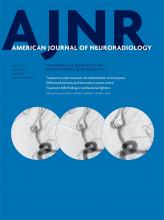Abstract
BACKGROUND AND PURPOSE: Multiple sclerosis monitoring is based on the detection of new lesions on brain MR imaging. Outside of study populations, MS imaging studies are reported by radiologists with varying expertise. The aim of this study was to investigate the accuracy of MS reporting performed by neuroradiologists (someone who had spent at least 1 year in neuroradiology subspecialty training) versus non-neuroradiologists.
MATERIALS AND METHODS: Patients with ≥2 MS studies with 3T MR imaging that included a volumetric T2 FLAIR sequence performed between 2009 and 2011 inclusive were recruited into this study. The reports for these studies were analyzed for lesions detected, which were categorized as either progressed or stable. The results from a previous study using a semiautomated assistive software for lesion detection were used as the reference standard.
RESULTS: There were 5 neuroradiologists and 5 non-neuroradiologists who reported all studies. In total, 159 comparison pairs (ie, 318 studies) met the selection criteria. Of these, 96 (60.4%) were reported by a neuroradiologist. Neuroradiologists had higher sensitivity (82% versus 42%), higher negative predictive value (89% versus 64%), and lower false-negative rate (18% versus 58%) compared with non-neuroradiologists. Both groups had a 100% positive predictive value.
CONCLUSIONS: Neuroradiologists detect more new lesions than non-neuroradiologists in reading MR imaging for follow-up of MS. Assistive software that aids in the identification of new lesions has a beneficial effect for both neuroradiologists and non-neuroradiologists, though the effect is more profound in the non-neuroradiologist group.
ABBREVIATIONS:
- NNR
- non-neuroradiologist
- NR
- neuroradiologist
- VT
- VisTarsier
- © 2017 by American Journal of Neuroradiology











